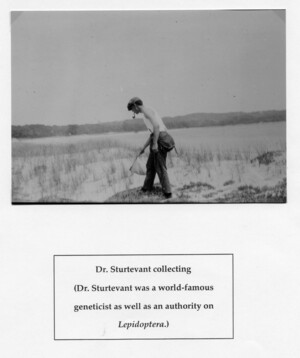The simplest and most obvious way to obtain marine specimens is just to grab a net and head down to the seashore. This was the primary method of collecting in the early days of the MBL, when there was not yet a group of people dedicated specifically to collecting. Sometimes collecting was done in small groups, other times it was done by students in the courses, but generally in the early years the students themselves were the ones collecting. They would simply go obtain whatever they needed and bring them back to the lab bench for research.
While nets were the primary tools for this endeavour, other useful tools included jars to put specimens in, wooden buckets (called “cannikins”), and lots of pockets! From the beginning, the MBL had a mixture of men and women in their science courses, and thus women made up a large percentage of collectors, as we can see in many of the archival photographs where they rolled up their skirts and waded into the marshes or dug things up along the seashore.
Collecting at the seashore benefited from more than just nets. Collecting the correct organisms and in sufficient quantities involved strategy and knowledge of the organism the researcher was looking for. For example, where does this creature live--in marshes or under docks? When does it reproduce? Can it be found during the day or only at night? An example of the peculiarity of certain organisms is seen in a letter an investigator named Tracy Sonneborn wrote in 1926. He wrote that he had to collect certain animals whose “mating reactions are governed by the moon.” To his family back home, he described how collecting these creatures is “a simple matter” and you just need a flashlight because they are “strongly attracted to the light...and swim right up to you so that they can be scooped out and brought to the lab” (Maienschein, Exploring Life, 98).
The students in the MBL courses remember collecting excursions as fun, something that provided a more complete experience than simply sitting at a lab bench. A student in the early years argued that there is something to feeling “what it’s like to wade one’s way through the meandering streams of a salt marsh and to become mired down in mud so that other students have to pull you and your rubber waders out with a loud sucking smack” (Maienschein, Exploring Life, 91).
A collecting tool that was a step above handheld nets, buckets, and jars, was the seine. A seine is a large fishing net that is weighted in such a way that it hangs vertically in the water. These nets were deployed right from the seashore, and the MBL archives have many pictures of people dragging in seines with their shallow water catches.
With the importance of nets for collecting and for the MBL as a whole, it should come as no surprise that these nets were valuable tools that required care and frequent mending. Many photos in the archives show boat captains and other dedicated crew members carefully working on nets. Trucks were also a useful tool for collecting, and the supply department had a fleet of service trucks that were often driven down to the seashore in order to haul organisms back to the lab.
- Dolgin, Elie, “The Squid Collector,” http://www.nature.com/news/not-your-average-technician-1.16785
- “John J. Valois, Obituary” http://www.mbl.edu/obituaries/john-j-valois/
- “John Valois, Longtime Specimen Collector and Naturalist, Honored at the Marine Biological Laboratory,” July 12, 2011, http://hermes.mbl.edu/news/press_releases/2011/2011_pr_07_12.html
- The Collecting Net Spring 2006, Vol. 2, No. 1 http://hermes.mbl.edu/publications/collecting_net/2006/06_01net06.html Accessed on July 16, 2015.
- Maienschein, Jane, and Ruth Davis. 100 years exploring life, 1888-1988: the Marine Biological Laboratory at Woods Hole. Jones and Bartlett Publishers, 1989.
- “MBL Moment with Dave Remsen,” MBL Catalyst January 2014, p 12-13. http://www.mbl.edu/wp-content/uploads/2013/07/Catalyst.Winter13-14.web_.pdf Accessed on July 16, 2015.
- Williams, Wendy. Kraken: The Curious, Exciting, and Slightly Disturbing Science of Squid. Abrams, 2011.

